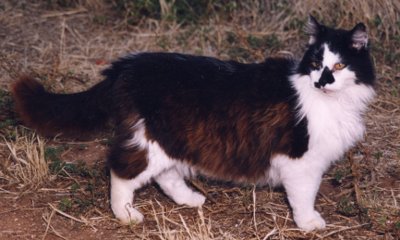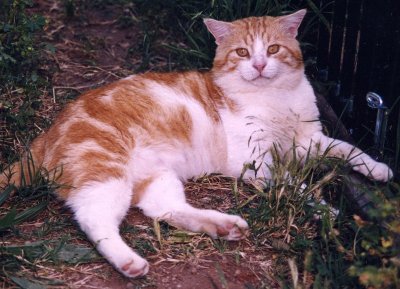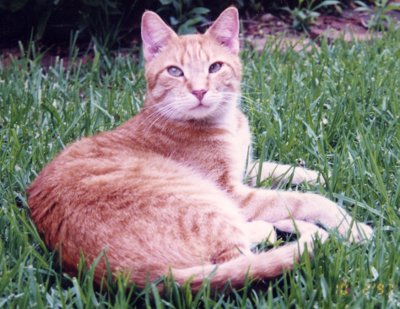Cats probably arrived in Australia before 1788 due to early European contacts. Since that time they have spread across the continent. Their disperal was assisted by farmers, who in the past deliberately released cats around burrows as a form of rabbit control (1).
Adult cats maintain discrete home ranges (2). They can breed at any time of the year. There is no specific breeding season, but most kittens are born in spring to late summer/autumn. Females average 2 litters a year, with an average of 4.4 kittens/litter.
 Even though juvenile survival is limited by the availability of easily caught prey, such as young rabbits (2), a cat population can increase dramatically.
Even though juvenile survival is limited by the availability of easily caught prey, such as young rabbits (2), a cat population can increase dramatically.
For example, in 1949, 5 cats were introduced to Marion Island. After 25 years, the population on the island was over 2000 (3).
Cats and endangered wildlife
It is fashionable in some conservation circles to blame cats for the perilous position of some native species. However, a more accurate and less emotive perspective comes from well-respected conservation biologists (1):
“Land clearance, mainly for agriculture, is perhaps the single most important cause of environmental degradation, and loss and depletion of species and ecological communities both in Australia and worldwide. Almost 80% of mammals and about 60% of birds listed by the IUCN have declined as a result of habitat loss.”

In terms of the diet of feral cats, it is important to remember the extent to which they prey on rabbits and introduced rodents.
- On Macquarie Island, 82% of the cat scats and 71% of the stomach contents examined contained rabbit remains (4).
- Around Lake Burrendong in central eastern NSW, 68% of the volume of cat scats was composed of rabbit, and a further 11% of carrion, that is, kangaroos killed by shooters and sheep that had died or been killed by a larger predator (5).
Scats were collected for 3 years, during which time the rabbit calicivirus arrived in this area of NSW. Even though the rabbit population declined by 90%, rabbits were still a major prey species. Ten months later, house mice increased as a component of the diet, maybe due to the decline in rabbits, but possibly just because they were plentiful, and cats are opportunistic predators. Few native mammals were eaten in this study, and birds are seldom an important prey item for mainland cats (5).
Worldwide, most extinctions have occurred on islands. Attention is often focussed on the role of introduced cats, but in fact rats are responsible for twice as many extinctions as cats (6). Rats alone prey on birds more effectively than cats alone in all life stages from eggs to ground-nesting adults. Rats are found on the majority of major island groups. Predation by cats can control their numbers and benefit bird populations, even when the cats themselves lightly prey on the birds. For example, on Stewart Island, remains of the endangered kakapo were found in 5.1% of cat scats, whereas rat remains were found in 93% of scats. Cats benefit the kakapo by reducing rat predation. An attempt to eradicate cats from Amsterdam Island was abandoned after rat and mouse populations increased rapidly.
On Raoul Island, rats were the most frequent prey found in both cat stomachs and scats. Bird remains found were those of common songbirds on the island; few seabirds were taken. There are many examples of islands where seabird populations have been reduced by Norway rats, and since rats are the predominant prey of cats, the researchers concluded: “One management option for Raoul Island is to eradicate cats but this may bring little benefit to bird populations.” (7).
Unless Norway rats could be eradicated at the same time as cats, “… the effort and expense involved in a cat eradication programme might be better spent on other conservation projects that are more assured of a positive outcome.” (7)
This point is well illustrated by the example of Macquarie Island, where cats were eliminated by 2001 (8). However, in the 6 years following the eradication, the rabbit population exploded, reversing all previous control efforts. As a result, vegetation cover was severely damaged and petrel burrows collapsed as a result of rabbit tunneling. Examination of stomach contents showed that cats had been major predators of rabbits. The 157 cats shot in 1997 would have eated 4000 adult sized rabbits, as well as 103,000 mice and 36,000 rats each year (8). Thus, the removal of cats had unintended and negative consequences.
Cat control methods
For decades, cats have been killed by various methods, such as trapping, poisoning and shooting. Such methods may not only cause suffering to the cats, but in the case of lactating females leaves kittens to slowly starve to death. In addition, these methods have not been effective in achieving a lasting population reduction.

Several authors have noted that conventional baiting is not effective because cats are not attracted to carrion (baits) when prey is plentiful (1, 2). Steel-jaw traps are inhumane, broadacre live trapping is impractical, and shooting where there is cover is extremely time consuming (2).
Death rate is only one factor determining population size – other factors include birth rate and immigration/emigration. When some cats are killed, those remaining continue to breed. Because there are now more vacant territories, and fewer cats hunting easily available prey, more juveniles are likely to survive and become established. They in turn will breed, and so the population returns to where it was before killing started.
References
- Burgman, M. & Lindenmayer, D. (1998). Conservation Biology for the Australian Environment. Surrey Beatty & Sons, Chipping Norton (NSW)
- Coman, B. (1991). The ecology and control of feral cats in Australia, in Potter, C. (ed), The Impact of Cats on Native Wildlife: Proceedings of a Workshop held on May 8-9 1991, ANPWS, Canberra
- Courchamp, F. & Cornell, S. (2000). Virus-vectored immunocontraception to control feral cats on islands: a mathematical model. Journal of Applied Ecology, 37: 903-913
- Jones, E. (1977). Ecology of the feral cat, Felis catus (L.), (Carnivora: Felidae) on Macquarie Island. Australian Wildlife Research, 4: 249-262
- Molsher, R., Newsome, A. & Dickman, C. (1999). Feeding ecology and population dynamics of the feral cat (Felis catus) in relation to the availability of prey in central-eastern New South Wales. Wildlife Research, 26: 593-607
- Courchamp, F., Langlais, M. & Sugihara, G. (1999). Cats protecting birds: modelling the mesopredator release effect. Journal of Applied Animal Ecology, 68: 282-292
- Fitzgerald, B., Karl, B. & Veitch, C. (1991). The diet of feral cats (Felis catus) on Raoul Island, Kermadec group. New Zealand Journal of Ecology, 15: 123-129
- Bergstrom D, Lucieer A, Kiefer K, Wasley J, Belbin L, Pedersen T & Chown S (2009). Indirect effects of invasive species removal devastate World Heritage Island. Journal of Applied Ecology, 46: 73-81